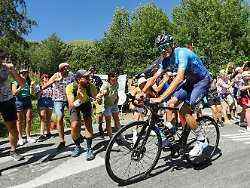On the legendary mountain of the tour
Chris Froome’s little cycling wonder
By Tobias Nordman
07/15/2022, 09:39 am
Chris Froome was once the merciless ruler of the Tour de France. But those times are long gone, a terrible fall in 2019 drove him close to the end of his career. But Froome didn’t want to stop, fought against pity and himself – and is now setting a remarkable example.
Chris Froome is no longer a man for the cameras. The 37-year-old, who dominated cycling between 2011 and 2017 with four Tour de France victories, two Vuelta victories and a Giro d’Italia triumph, has become a competitor in the pack. Still recognizable by his driving style, so quirky but once so merciless. Dominant past, the present looks different. Gray. The main roles in cycling have long since been reassigned, at the Tour de France 2022 they will be occupied by drivers such as Tadej Pogacar, Jonas Vingegaard, Primoz Roglic, Lennard Kämna or Simon Geschke.
They tell the big stories. From Broken Heroes (Pogacar). From New Heroes (Vingegaard). Of fallen heroes (Roglic). Of heroes without a crown (Kämna). And of furiously fighting and suffering heroes (Geschke). Froome does not find a place in this list (anymore). Until the day that led the field up to Alpe d’Huez. These 21 magical hairpin bends in which the tour has so often decided. No route in cycling is more mystical than that from Le Bourg d’Oisans to the ski area. The ascent is not the steepest, not the highest and not the longest that the program of the tour includes. But the most legendary.
The small big victories
For the drivers, Alpe d’Huez is party, intoxication and hangover all in one. Unforgotten are the pictures of Marco Pantani, who once flew up this mountain. In 1995 he thundered over the 13.8 kilometers in 36:50 minutes. Nobody has ever been faster. Neither does Lance Armstrong. The insatiable American. His most spectacular moment: the big bluff of 2001. He pretended to be having a bad day until he entered the mountain. A play with a merciless punch line. At the foot of the climb, he let his helper José Luis Rubiera drive at high speed, turned back to his opponent Jan Ullrich – and drove away. “The Look” is legend.
Froome was a different guy. Not as spectacular as the Italian pirate. Not as intimidating as the possessed American. But just as grueling (and in the doping twilight) as the two. Story. The great successes for the Brit are now defined differently. Smaller. With a third place in Alpe d’Huez, for example. “I can be very satisfied with how I drove today,” said Froome. “I fought my way up from the bottom and I’m still fighting to get back to the form I was,” said the 37-year-old. Another big step on the way back to the elite. A next big step after the horror crash that had pushed his career very close to a tragic end.
A fatal inattention
In the summer of 2019, Froome crashed into a house wall at 54 kilometers per hour. He wanted to blow his nose on a descent, took one hand off the handlebars, a gust of wind caught his front wheel – then the accident. He fractured a thigh, hip, elbow and several ribs. He had to be operated on in the hospital for eight hours. Everything changed for the Brit. But he didn’t want to give up, he fought back. Changed team, moved from Sky (now Ineos) to Israel-Premier Tech. And he’s still chasing the dream he actually wanted to fulfill in 2019 before he let go of his handlebars for a fatal second.
Froome wants to win the Tour de France for the fifth time. “It won’t happen this year, but I still dream of it,” he said last week. Even then he had no chance. In the overall standings he is 29th after twelve stages and is already 54:16 minutes behind Vingegaard, the man in yellow.
Why is he still doing this?
The man with the precise attacks has become a man whom some look at with sympathy. Who at the 2022 Tour provided images of exhaustion that raised questions about his competitiveness. Why is he still doing this? Because, like so many great champions, he’s obsessed. Realism doesn’t play a major role in this world. The longing to show it all again eats everything else. “In the past three years I’ve come back after my terrible fall. I didn’t want my career to end like this,” said Froome before his little miracle: “That’s what gets me out of bed every morning.”
This Thursday he defied all the swansongs. Has received every pity. Drive boldly and aggressively. In the end, however, he was no longer able to follow his opponents Thomas Pidcock (stage winner) and Louis Meintjes. It was enough for third place. Perhaps even more important than a possible victory, however, was admiration for Froome’s little resurrection. Pidcock, who is already seen as the 37-year-old’s successor and future Tour champion, praised his British colleague’s performance. “He’s a legend,” said the mountain bike Olympic champion. “He may not be as fast as he used to be, but he’s still big.” For the first time since his fall, he finished in the top ten in a race. On the mountain of legends. He couldn’t have picked a better place to become a man for the cameras again.
